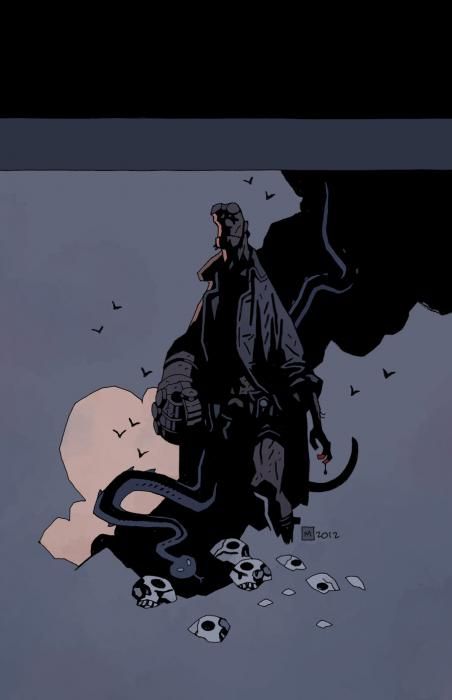In "Hellboy in Hell" #3, Mike Mignola continues Hellboy's journey in Hell as he discovers more about his past and his family.
Mignola succeeds in bringing the mood of Shakespearian tragedy to this chapter of Hellboy's life. Plot tropes like a struggle for succession and themes of blood and guilt and responsibility loom as large here as they do in "Macbeth" or "Hamlet." A bloody dagger, that resonant symbol of violence and shame, has a beautifully composed panel to itself.
The events themselves have the feeling of a half-understood nightmare, broken up only by Hellboy's down-to-earth observations and comments. "Hellboy in Hell" #3 is disorienting as a narrative, but it all seems intentional on Mignola's part in order to add to the atmosphere and feeling of horror, for the usually unflappable Hellboy is as shaken up by the scenery and events as the reader will likely be.
Mignola's art is beautiful as usual, with his angular lines and heavy shadows and inks that are minimal but expressive. The endless gothic tunnels and endless underground atriums of Pandemonium and other Hellish regions give Mignola ample canvas for visual fireworks. His backgrounds contain details like patterns etched in the stone of enormous walls. Early in "Hellboy in Hell" #3 there is a knockout panel with serpentine Angels of Destruction twisting across a purplish-pink sky or stars twinkling in a sky that stretches comb-like fingers upwards.
A twist in the plot in the middle "Hellboy in Hell" begins with panel of family blood spilt on a glacial blue landscape of ice and snow, interrupting by a spectacular entrance from an unexpected direction. This sequence of seven panels begs to be remembered for its splendor and sense of drama, as does the five panels that end "Hellboy in Hell" #3.
Dave Stewart's colors are in sync with the mood that Mignola creates, conveying not only the desolation and tomb-like spaces of Hell, but its grandeur and richness as well. Hell is magnificent, fearsome but not dour, clothed in purple shadows, green-blue light and liquid bright red.
The art dominates "Hellboy in Hell" #3, but Mignola's dialogue comes in short but significant bursts, which are enough to provide more family history and to convey Hellboy's awe and growing confusion. Despite the distressing events and revelations, Hellboy largely remains his usual irreverent and ironic self, composed enough to make a "The Grapes of Wrath" joke. His guy-next-door reactions are a foil to his setting and the elegiac speech of Hell's denizens. Mignola's prose in the text boxes feels ominous and poetic with his use of repetition and foreboding phrases, but he keeps it casual and light for Hellboy's lines. Hellboy is a bright spot of comedy in this sea of somberness when he utters characteristic phrases like "Hey, watch it!" when one of his relatives complains of his human stink.
The art and the tone of "Hellboy in Hell" #3 are grim and beautiful, somber and graceful, with a creepiness from a deep and endless space instead of screams or violence, but Mignola also keeps the humor and offbeat charm of Hellboy himself intact, making for unusual but haunting combination.

